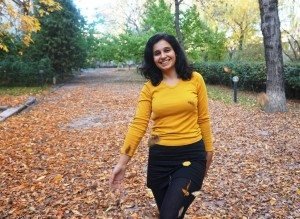By Ani Galustian

On an early autumn day, the 6th grade class from Yerevan’s School No. 160 visits Armenia Tree Project’s (ATP) nursery in Karin Village for a lesson on the environment. Accompanied by their history teacher, the class is greeted by ATP’s environmental education teacher, Nvard Gevorgyan.
The Michael and Virginia Ohanian Environmental Education Center at Karin Nursery is visited by students from all over the country almost every day, mostly by schoolchildren but also by university students. Students learn about the importance of protecting the environment by having theoretical classes, visiting the fields of the nursery, and participating in the work.
Now, more than ever, Armenia is in desperate need of environmental stewards to protect its natural heritage. Mass deforestation is a major issue; in the past month alone, 1,000 trees were cut from the forests in Lori. If the trend of deforestation continues at the current rate, Armenia could have virtually no forests left by 2020.
But how can people be expected to value nature, when they are so detached from it? The children of today mostly grow up indoors. They are strangers to the natural world we live in. Not only does this lifestyle present a danger to their health but that of our planet as well. The earth is under great threat when those who are responsible for creating a sustainable future are indifferent when it comes to environmental issues.
ATP believes the answer is in education. As one of its core programs, ATP has been working hard to instill respect, care, and understanding towards nature in young generations of Armenians. Thousands of children visit ATP’s two Ohanian education centers each year—one in Karin and another in Margahovit Village—and receive lessons to raise interest, appreciation, and awareness of natural ecosystems and sustainable practices.

Today’s environmental class, led by Gevorgyan, begins with the fascinating life and diversity of insects. The children watch a colorful slideshow and listen with eyes wide open to stories about the curious shape of insects’ eggs, up to the impressive journeys of the monarch butterfly.
The class teacher, Alla, is excited about the visit: “After several kids from our school visited the ATP center I got interested in the project. This is the second class I’ve brought to participate in the environmental lessons.”
Next, Alla wants students to plant trees in their schoolyard. “The process of planting a tree, looking after it, taking care of it…this will be a special experience for my kids,” she says.
After being asked why environmental education is so important for her, Alla says, “One can observe a change in the behavior of the children after visiting ATP. When I go to the next excursion with these children they won’t leave their litter behind, they will care more about nature. Isn’t that reason enough?”
The children go outside to the fields of the nursery, discovering the diversity of species in the gardens of Karin, where approximately 60 fruit and decorative trees are cultivated. They admire colorful flowers, decorative shrubs, and the rich fruit. At the end of the visit, the children have lunch on the terrace and enjoy the last warm sunrays of summer.
‘One can observe a change in the behavior of the children after visiting ATP. When I go to the next excursion with these children they won’t leave their litter behind, they will care more about nature.’
These short visits make the students realize just how powerful they are. They begin to understand how big of an impact each action or inaction of theirs can have on the environment. Gevorgyan plants seeds of consciousness in them, which with the proper care will to grow and help them become responsible citizens and advocates of change.
At the end of the day, Gevorgyan talks with the children about their impressions and asks what they liked most about their visit. A boy named Ruben steps to the front and says he liked the beautiful flowers most. He adds that he liked seeing a pomegranate hanging on a tree for the first time. Alen says he was surprised to learn about all the different species of firs. He also saw trees he didn’t even know existed. Jana and Ellen found it fascinating to learn about the lives of insects and how the caterpillar becomes a butterfly. Gevorgyan nods at that and adds, “True, this is one of the biggest wonders of nature.”
Ani Galustian is a volunteer with Armenia Tree Project from Hamburg, Germany. She studied at the University of Hamburg with a special interest in wood biology and tree physiology. Galustian has a passion for nature. She came to Armenia with Birthright Armenia to experience life in her homeland and to improve her Armenian-language skills.



Be the first to comment